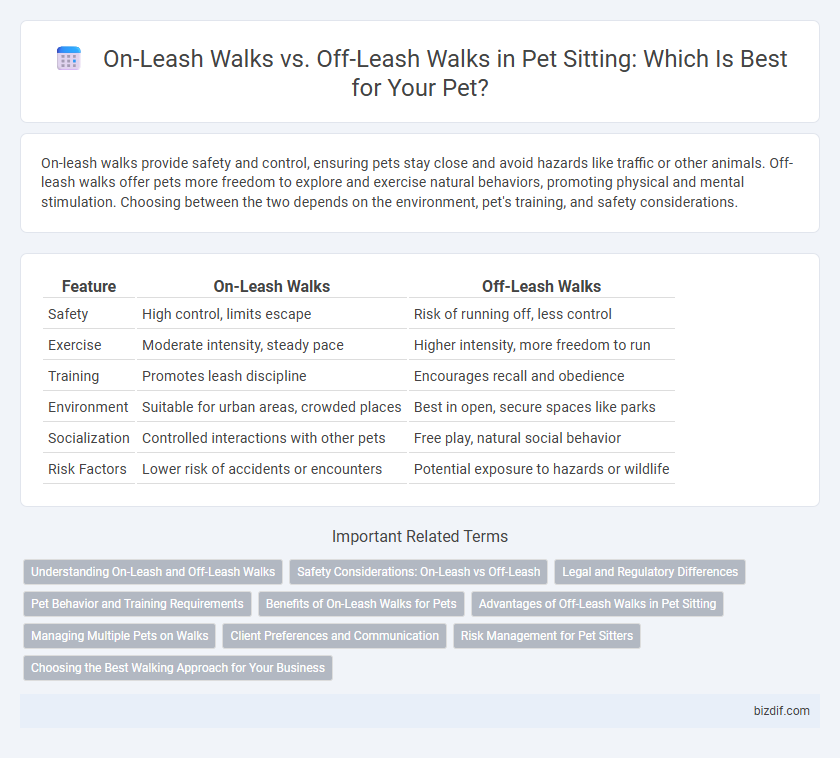On-leash walks provide safety and control, ensuring pets stay close and avoid hazards like traffic or other animals. Off-leash walks offer pets more freedom to explore and exercise natural behaviors, promoting physical and mental stimulation. Choosing between the two depends on the environment, pet's training, and safety considerations.
Table of Comparison
| Feature | On-Leash Walks | Off-Leash Walks |
|---|---|---|
| Safety | High control, limits escape | Risk of running off, less control |
| Exercise | Moderate intensity, steady pace | Higher intensity, more freedom to run |
| Training | Promotes leash discipline | Encourages recall and obedience |
| Environment | Suitable for urban areas, crowded places | Best in open, secure spaces like parks |
| Socialization | Controlled interactions with other pets | Free play, natural social behavior |
| Risk Factors | Lower risk of accidents or encounters | Potential exposure to hazards or wildlife |
Understanding On-Leash and Off-Leash Walks
On-leash walks provide controlled environments essential for pets' safety, especially in urban areas or near traffic, ensuring owners maintain immediate control. Off-leash walks offer pets freedom to explore and exercise, boosting physical and mental health, but require safe, enclosed spaces and reliable recall skills. Understanding these dynamics helps pet sitters tailor walks to each pet's temperament and environment, enhancing overall wellbeing and safety.
Safety Considerations: On-Leash vs Off-Leash
On-leash walks provide controlled safety by preventing dogs from running into traffic or encountering aggressive animals, reducing the risk of injury or loss. Off-leash walks offer more freedom but require secure, enclosed areas and well-trained dogs to prevent accidents or escapes. Owners must assess their pet's behavior and the environment to choose the safest walking option.
Legal and Regulatory Differences
On-leash walks comply with most local leash laws designed to ensure public safety and reduce wildlife disturbances, minimizing legal liabilities for pet sitters. Off-leash walks require specific permits or access to designated dog parks where local regulations permit free movement, making adherence to jurisdictional rules crucial. Failure to follow leash laws can result in fines or penalties, emphasizing the importance of understanding regional legal frameworks when providing pet sitting services.
Pet Behavior and Training Requirements
On-leash walks help reinforce obedience and control, promoting consistent pet behavior by limiting distractions and enabling immediate correction from the sitter. Off-leash walks require advanced training and strong recall skills to ensure safety and prevent unpredictable behavior, as pets have more freedom to explore and interact. Proper assessment of a pet's training level and temperament is essential before offering off-leash sessions to maintain a positive and secure experience.
Benefits of On-Leash Walks for Pets
On-leash walks provide enhanced safety for pets by preventing encounters with traffic, aggressive animals, or hazardous environments, significantly reducing the risk of injury. These controlled walks also improve training opportunities, reinforcing obedience and recall commands, which strengthens the pet's behavior and owner-pet bond. Maintaining leash control ensures that pets receive consistent exercise while allowing pet sitters to monitor health indicators closely and manage social interactions effectively.
Advantages of Off-Leash Walks in Pet Sitting
Off-leash walks in pet sitting offer dogs greater freedom to explore and engage their natural instincts, promoting enhanced physical exercise and mental stimulation. This freedom helps reduce stress and anxiety, leading to improved overall behavior and socialization skills. Safely managed off-leash walks also allow pets to build trust and stronger bonds with their sitter, creating a more positive and enriching pet care experience.
Managing Multiple Pets on Walks
Managing multiple pets on walks requires balancing control and freedom responsibly. On-leash walks ensure safety and prevent pets from running off, ideal for busy or urban areas. Off-leash walks foster natural behavior and exercise but demand strict obedience and low-distraction environments to prevent conflicts or accidents.
Client Preferences and Communication
Clients often have specific preferences regarding on-leash versus off-leash walks based on their pet's behavior, safety concerns, and local regulations. Clear communication about these preferences helps ensure tailored care that aligns with the pet owner's expectations and maintains trust. Regular updates and feedback during walks support transparency and enhance client satisfaction in pet sitting services.
Risk Management for Pet Sitters
On-leash walks provide pet sitters with greater control and reduce the risk of pets running into traffic or encountering aggressive animals, ensuring safer outings. Off-leash walks demand rigorous assessment of the environment, pet behavior, and recall reliability to minimize risks of escape or injury. Implementing clear protocols and client communication is essential to effectively manage liability and prioritize pet safety during varied walking situations.
Choosing the Best Walking Approach for Your Business
On-leash walks provide pet sitters with enhanced control and safety, especially in urban or high-traffic areas, reducing the risk of pets running off or encountering hazards. Off-leash walks offer dogs greater freedom to exercise and explore, which can improve their physical and mental well-being but require secure, enclosed environments and well-trained pets to prevent escapes or conflicts. Balancing client preferences, pet behavior, and location safety is essential when choosing between on-leash and off-leash walking approaches to ensure the best care and reputation for your pet sitting business.
On-leash walks vs Off-leash walks Infographic

 bizdif.com
bizdif.com